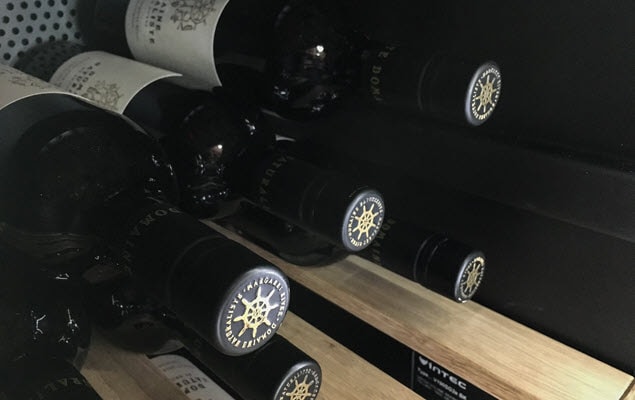1. Stacking different shapes and sizes

The first thing to know is that the capacities of all wine cabinets are expressed based on standard 750mL Bordeaux (shape and size). This is a standard among all wine cabinet and wine cellar manufacturers, as for a very long time it was the most common bottle shape.

Although many bottles may look like standard Bordeaux bottles, most actually considerably vary in terms of diameter, height, length of the neck and shoulder etc. – even among bottles from the Bordeaux region! Here’s the standard 750mL Bordeaux shape and size which all wine cabinet capacities are based on:
Obviously, wine cabinets can accommodate different shapes and sizes, but sometimes at the detriment of the maximum capacity.
2. Reaching maximum capacity

Please be aware when stacking your cabinet that some bottles will not fit opposite each other and you may need to lay the bottles opposite more suitably shaped bottles.
To reach maximum capacity, most cellars also require stacking of bottles on multiple levels, which makes getting the layout of bottles “right from the start” all the more important (see tip no 3 which will help you achieve multiple levels of bottle stacking).
Another important point to take into consideration is the fact that the more shelves you have loaded in your wine cabinet, the lesser the total capacity as a general rule – as shelves take up space, and shelves “on every level” tends to restrict the bottle diameters which the shelves can accommodate.
HINT: removing a few shelves from your cabinet can sometimes help store more wine, and also bottles of unusual shapes or large diameters (such as wide Champagne bottles), as less shelves frees up “vertical” space.
For this same reason, some wine cabinets require that you use less shelves than what is supplied to reach maximum capacities. The default shelving layout in these specific cabinets is generally designed more for optimal accessibility rather than maximisation of capacity.
In an effort to clarify these important capacity considerations, and to clearly highlight the difference between maximum cellar capacities (e.g. for very long-term cellaring) and more realistic “everyday use” cellar capacities, we’ve recently included in all our product information a useful distinction between “easy” and “max” capacities, defined as follows:
- EASY = capacity which can be reached with all supplied shelves installed and with a maximum of 4-5 levels of stacking per shelf.
- MAX = maximum capacity which can be reached. For some models, reaching this capacity requires using less shelves than what is supplied.
3. Stacking for accessibility

When stacking bottles in your cabinet, it is practical to keep bottles from the same case together. See the diagrams above where bottles from the same case are represented in the same colours.
Storing same-case bottles in a vertical stack enables you to have easy access to all your different wines, and also facilitates interlocking bottles by laying suitably shaped bottles neck-to-neck.
4. Stacking your wines for ageing

When filling your cabinet, we suggest stacking the bottles you wish to cellar and mature at the back of the shelves, and the wines you wish to consume in the short-term at the front.
We then recommend that while doing your required annual cellar maintenance (see "Six expert tips for cellar care"), you re-evaluate which wines should be moved forward having approached drinking age, and which bottles should remain stored away for longer periods.





